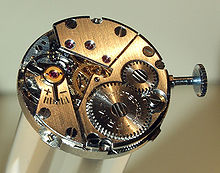Clockwork: Difference between revisions
ClueBot NG (talk | contribs) m Reverting possible vandalism by 173.30.2.188 to version by Yobot. False positive? Report it. Thanks, ClueBot NG. (205834) (Bot) |
No edit summary |
||
| Line 1: | Line 1: | ||
{{other uses}} |
{{other uses}} |
||
| ⚫ | |||
{{Fix bunching|beg}} |
|||
| ⚫ | |||
{{Fix bunching|mid}} |
|||
[[File:Prim clockwork.jpg|thumb|Clockwork of mechanical Prim wrist watch]] |
[[File:Prim clockwork.jpg|thumb|Clockwork of mechanical Prim wrist watch]] |
||
{{Fix bunching|end}} |
|||
A '''clockwork''' is the inner workings of either a mechanical [[clock]] or a device that operates in a similar fashion. Specifically, the term refers to a mechanical device utilizing a complex series of [[gear]]s.<ref>[http://www.merriam-webster.com/dictionary/clockwork clockwork - Definition from the Merriam-Webster Online Dictionary<!-- Bot generated title -->]</ref><ref>[http://dictionary.reference.com/browse/clockwork clockwork - Definitions from Dictionary.com<!-- Bot generated title -->]</ref> |
A '''clockwork''' is the inner workings of either a mechanical [[clock]] or a device that operates in a similar fashion. Specifically, the term refers to a mechanical device utilizing a complex series of [[gear]]s.<ref>[http://www.merriam-webster.com/dictionary/clockwork clockwork - Definition from the Merriam-Webster Online Dictionary<!-- Bot generated title -->]</ref><ref>[http://dictionary.reference.com/browse/clockwork clockwork - Definitions from Dictionary.com<!-- Bot generated title -->]</ref> |
||
Revision as of 19:57, 14 March 2011


A clockwork is the inner workings of either a mechanical clock or a device that operates in a similar fashion. Specifically, the term refers to a mechanical device utilizing a complex series of gears.[1][2]
Overview
Often power for the device is stored within it, via a winding device that applies mechanical stress to an energy-storage mechanism such as a spring, thus involving some form of escapement; in other cases, hand power may be utilized. The use of wheels, whether linked by friction or gear teeth, to redirect motion or gain speed or torque, is typical; many clockworks have been constructed primarily to serve as visible or implicit tours de force of mechanical ingenuity in this area. Sometimes clocks and timing mechanisms are used to set off explosives, timers, alarms and many other devices.
Examples
The most common examples are mechanical clocks - hence the name. Others include:
- Toys - often as a simple mechanical motor, or to create automata. These may be either key-wound, or a simpler pullback motor.
- Mechanisms to turn the lens of lighthouses before electric motors.
- Babbage's difference and analytical engines, and simpler mechanical calculators.
- Astronomical models, such as orreries whose history spans hundreds of years.
- Music boxes, which were very popular during the 19th century and at the beginning of the 20th.
- Almost all phonographs built before the 1930s.
- Low-powered electrical equipment, such as a clockwork radio, where an energy-storing spring accounting for much of the size and weight of the device spins a much smaller electric generator; such equipment is very popular where batteries and mains power (house current) are scarce.
- The Antikythera mechanism, an ancient clockwork calculator
